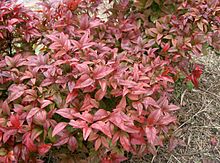| Nandina domestica | |
|---|---|

| |
| Scientific classification | |
| Kingdom: | Plantae |
| Clade: | Tracheophytes |
| Clade: | Angiosperms |
| Clade: | Eudicots |
| Order: | Ranunculales |
| Family: | Berberidaceae |
| Genus: | Nandina Thunb. |
| Species: | N. domestica
|
| Binomial name | |
| Nandina domestica | |
Nandina domestica (/nænˈdiːnə/ nan-DEE-nə)[a][b][c] commonly known as nandina, heavenly bamboo or sacred bamboo, is a species of flowering plant in the family Berberidaceae, native to eastern Asia from the Himalayas to Japan. It is the only member of the monotypic genus Nandina. It is widely grown in gardens as an ornamental plant with a number of cultivars that display bright-red fall foliage in the cool months, and attractive new foliage growth in spring. Although a popular ornamental shrub, the berries are toxic to birds,[2] especially towards the end of the winter when other food sources become scarce.[3]
The Latin genus name Nandina is derived from the Japanese name nanten (南天).[4] The specific epithet domestica means 'domesticated', or 'of the household'.[4]
Cite error: There are <ref group=lower-alpha> tags or {{efn}} templates on this page, but the references will not show without a {{reflist|group=lower-alpha}} template or {{notelist}} template (see the help page).
- ^ "Nandina". Oxford English Dictionary (Online ed.). Oxford University Press. (Subscription or participating institution membership required.)
- ^ Davis, Jerry W. (28 January 2016). "Nandina Berries Kill Birds". Audubon Arkansas. Retrieved 17 December 2020.
- ^ Cite error: The named reference
:0was invoked but never defined (see the help page). - ^ a b Gledhill, David (2008). "The Names of Plants". Cambridge University Press. ISBN 9780521866453 (hardback), ISBN 9780521685535 (paperback). pp 145, 268